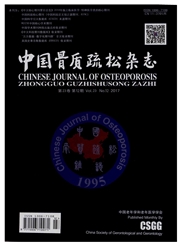

 中文摘要:
中文摘要:
目的研究P物质(substance P,SP)对脊髓损伤(spinalcordinjury,SCl)大鼠骨髓间充质于细胞(mesenchymalstem cells,MSCs)源性成骨细胞RANKL/OPG表达的影响,从而揭示SP在骨代谢中的作用。方法20只雄性6w龄SD大鼠制作脊髓损伤模型。3w后测定胫骨骨密度,收集股骨髓腔细胞悬液,MSCs诱导成骨细胞培养至第二代,用10^-8 mol/LSP进行作用。用免疫细胞化学的方法进行RANKL和OPG的染色并定量分析;用半定黾RT—PCR分析RANKL、OPG、Coilctl、OCN基因的表达变化;用EIA方法检测细胞培养基中RANKL和OPG蛋白的表达变化。结果3w时SCI组胫骨的骨密度明显低于SHAM组,骨密度的下降既发生在弪骨近端千骺端(-26.3%,P〈0.05),义发生在胫骨r(-21.2%,P〈0.05)。通过免疫细胞化学的方法进行定量分析显示,SP处理后比不加处理因素的MSCs源性成骨细胞表达RANKL显著增加(P〈0.05)。SP作用72b后MSCs源性成骨细胞RANKL的表达显著上调(+160.2%,P〈0.01),OPG的表达显著下调(-45.5%,P〈0.01),OCN的表达显著下降(-42.9%,P〈0.01)。结论SP在成骨细胞与破骨细胞偶联的关系中发挥重要作用。它既町以对成骨细胞产生直接作用(抑制OCN的基因表达),又可以通过成骨细胞间接的作用于破骨细胞(促进RANKL表达,抑制OPG表达),增强破骨细胞的活性,导致骨吸收和骨形成失衡,最终发生骨质疏松。
 英文摘要:
英文摘要:
Objective To investigate the effect of substance P (SP) on the expression of RANKL/OPG of osteoblasts derived from bone marrow mesenchymal stem cells (MSCs) in spinal cord injury (SCI) rat . The purpose of the study was to reveal the role of SP in bone metabolism. Methods Twenty male SD rats were randomly allocated to SCI group. BMD of tibiae was measured at 3 weeks. MSCs from femurs were cultured under control mediums and induced to become osteoblasts. The cells were treated with or without 10 -SM SP. The expressions of RANKL, OPG, Collctl, and OCN genes in the second generation osteoblasts were evaluated by immunocytochemistry and RT-PCR methods. Also, the content of RANKL and OPG proteins in these cells treated with SP was evaluated by E1A method. Results The BMD of tibiae in SCI was lower than that in SHAM ( proximal metaphyses: - 26.3% , P 〈0. 05 ; shaft : - 21.2% , P 〈 0. 05 ). The quantitative analysis of immuocytochemistry suggested that the expression of RANKL in osteoblasts treated with SP was more than CON (P 〈 0.05 ). Gene expressions of RANKL, OPG, and OCN in osteoblasts treated with SP 72 h were still significantly different with CON osteoblasts ( RANKL + 160. 2%, P 〈0. 01 ; OPG -4-5.5% , P 〈 0. 01 ; OCN -42.9% ,P 〈 0. 01 ). Conclusion SP played a very important role in the couple interaction between osteoblasts and osteoelasts. The direct effect of SP on osteoblasts was to inhibit the expression of OCN gene. The indirect effect was to inhibit the expression of OPG gene and enhanced the expression of RANKL gene.
 同期刊论文项目
同期刊论文项目
 同项目期刊论文
同项目期刊论文
 期刊信息
期刊信息
